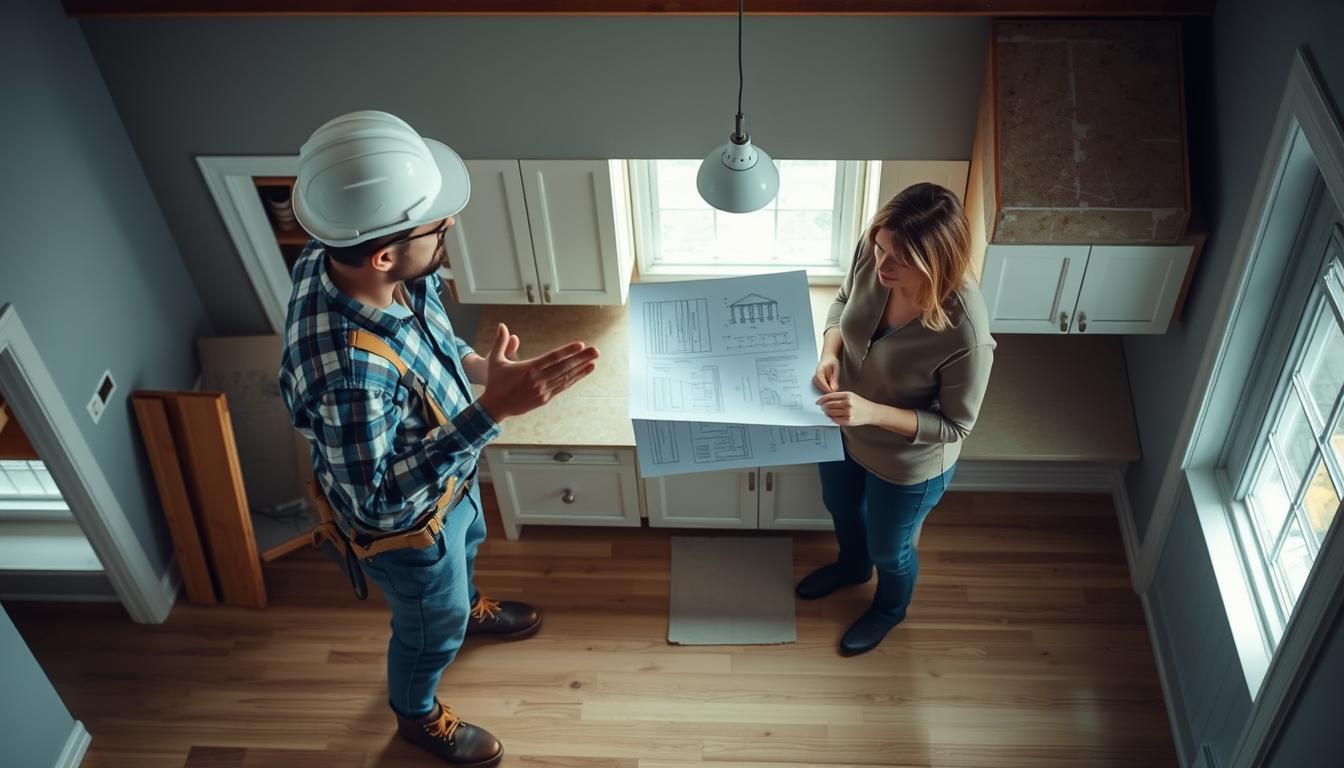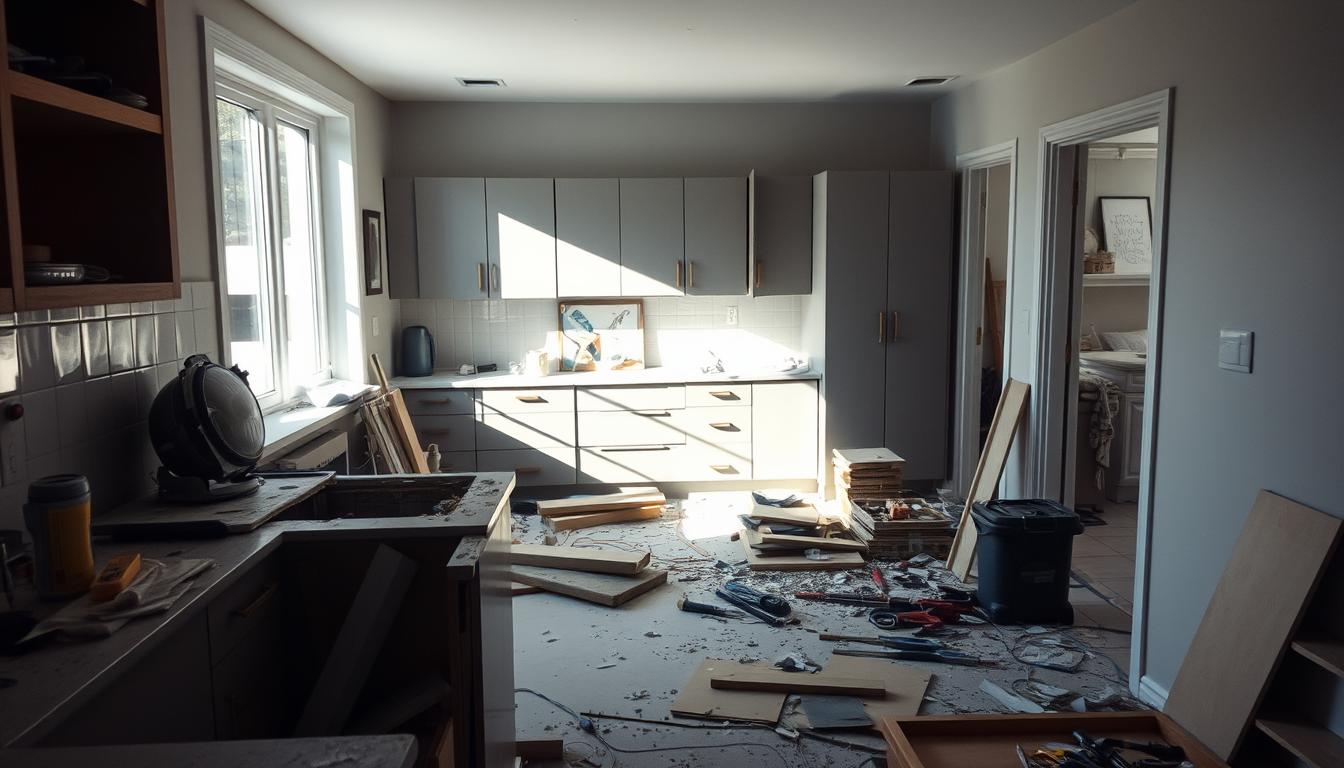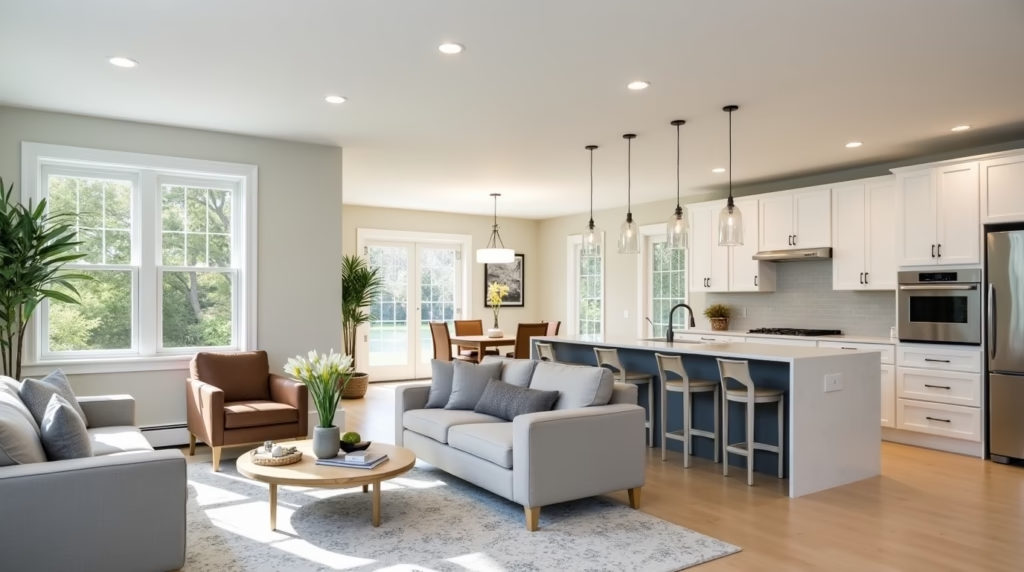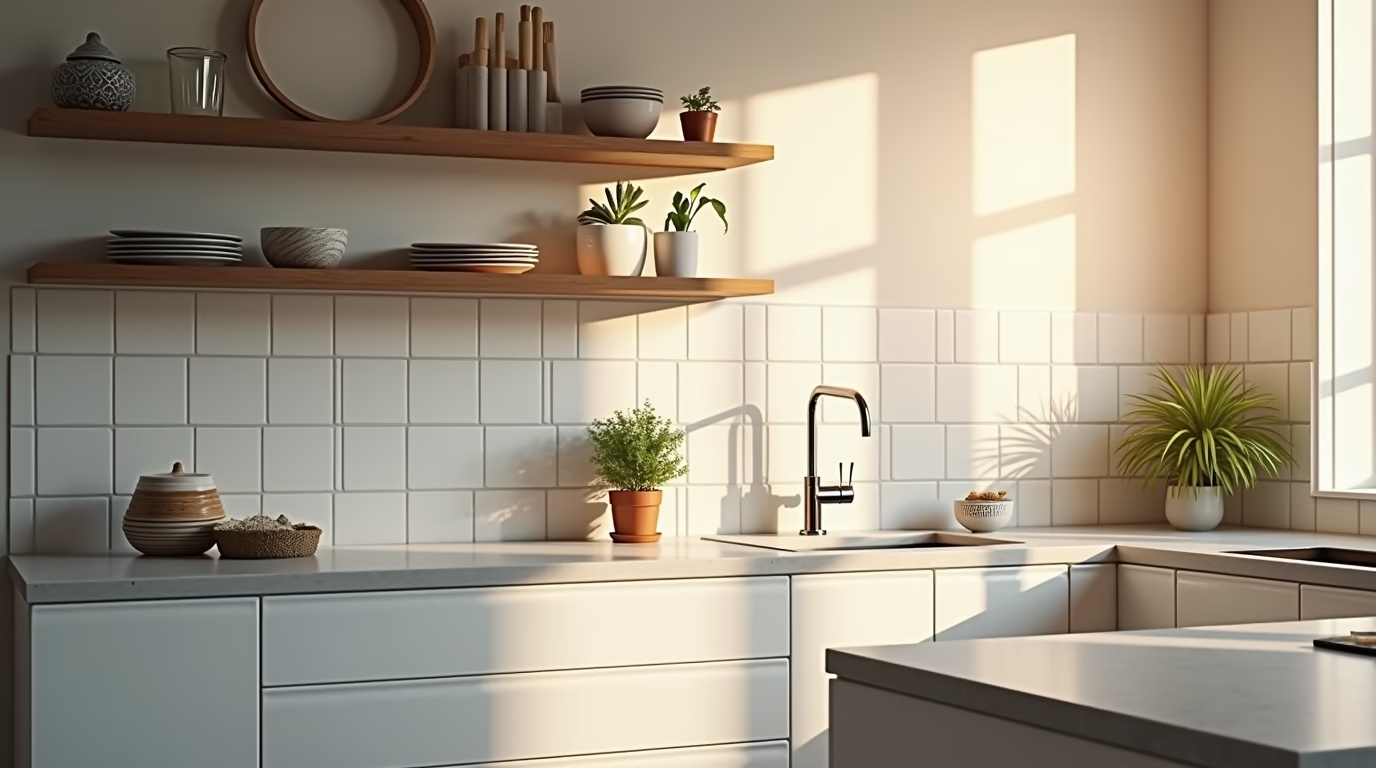Renovating my kitchen was a journey filled with valuable lessons. From the initial planning stages to the final reveal, I discovered crucial insights that I wish I had known from the start. In this article, I’ll share the top 8 lessons I learned during my kitchen renovation and how I would approach it differently if given the chance.

Through this experience, I gained a deeper understanding of kitchen design and the importance of meticulous planning in kitchen remodeling. Whether you’re considering a minor update or a full-scale renovation, my story aims to provide you with practical advice and inspiration for your own project.
Key Takeaways
- Understand the importance of planning in kitchen renovation.
- Learn from common mistakes in kitchen remodeling.
- Discover key considerations for effective kitchen design.
- Gain insights into managing renovation lessons for future projects.
- Explore how to approach kitchen renovation differently with hindsight.
My Kitchen Renovation Journey: The Good, The Bad, and The Unexpected
Renovating my kitchen was a rollercoaster ride filled with unexpected surprises and hard-won insights. As I look back on the experience, I’m reminded of the reasons that drove me to undertake this significant home improvement project.
Why I Decided to Renovate
My decision to renovate the kitchen was motivated by a desire to enhance the functionality and aesthetic appeal of the space. With a growing family, I needed a more efficient layout that could accommodate multiple cooks and provide ample storage. The outdated design and lack of modern appliances were also significant factors in my decision.
The Initial Vision vs. Reality
The initial vision for my kitchen renovation was to create a bright, airy space with modern finishes and state-of-the-art appliances. However, as the project progressed, reality set in, and I encountered several challenges, including delays and budget overruns. Despite these setbacks, I was determined to bring my vision to life.
One of the most significant aspects of my kitchen renovation journey was understanding the importance of measuring spaces accurately, much like considering the average dimensions of a living room when choosing furniture. Ensuring that my kitchen island was proportionate to the room was crucial.
| Aspect | Initial Plan | Reality |
|---|---|---|
| Budget | $10,000 | $15,000 |
| Timeline | 8 weeks | 20 weeks |
| Cabinets Depth | Standard 24 inches | Custom 27 inches |
As I navigated the complexities of my kitchen renovation, I learned valuable lessons about planning, budgeting, and the importance of flexibility. These insights have been invaluable in helping me navigate the challenges of home improvement projects.
Lesson1: Budget Planning Is Everything
One of the most crucial lessons I’ve learned from my kitchen renovation is the importance of thorough budget planning. A well-planned budget is the backbone of any successful renovation project.
How My Budget Spiraled Out of Control
Initially, I underestimated the costs involved in my kitchen renovation. The excitement of transforming my kitchen led me to overlook some critical expenses, causing my budget to spiral out of control. Unexpected costs such as plumbing and electrical changes added significant amounts to my initial budget.

Creating a Realistic Budget with Contingency
To avoid a similar situation, it’s essential to create a realistic budget that includes a contingency fund. Experts recommend allocating at least 10% to 20% of your budget for unexpected expenses. This buffer can help absorb any financial shocks during the renovation.
Tools I Wish I’d Used for Financial Planning
Utilizing the right tools for financial planning can make a significant difference. I wish I had used budgeting apps or software to track my expenses more efficiently. For those considering siding replacements or other external renovations, understanding how much siding costs for a house or comparing hardiplank siding vs vinyl can also be crucial in overall budget planning.
Effective budget planning is not just about sticking to a budget; it’s about being prepared for the unexpected. By doing so, you can ensure that your kitchen renovation stays on track financially.
Lesson2: Contractor Selection Requires Due Diligence
When I embarked on my kitchen renovation, I underestimated the importance of thoroughly vetting my contractor. This decision led to a series of challenges that could have been avoided with proper due diligence.
My Contractor Nightmare
My experience with my contractor was far from smooth. Delays, cost overruns, and subpar workmanship were just a few of the issues I faced. It became clear that I had not done enough research on my contractor before signing the contract.
To avoid similar pitfalls, it’s crucial to check a contractor’s references, verify their licenses, and review their insurance coverage. A simple phone call or email to previous clients can reveal a lot about a contractor’s reliability and work quality.
Questions I Should Have Asked
In hindsight, there were several questions I should have asked my contractor before hiring them. These include:
- What is your experience with kitchen renovations?
- Can you provide references from previous clients?
- What is your payment schedule, and are there any hidden costs?
- How will you handle unexpected issues that arise during the renovation?
Red Flags I Missed Along the Way
There were several red flags that I missed during the contractor selection process. These included:
| Red Flag | Description |
|---|---|
| No Clear Contract | A contractor who is unwilling to provide a detailed contract is a risk. |
| Poor Communication | If a contractor is unresponsive or unclear in their communication, it’s a sign of potential problems. |
| No Licenses or Insurance | A contractor without proper licenses and insurance is a liability. |
By being aware of these potential issues and taking steps to vet contractors thoroughly, homeowners can avoid many of the pitfalls associated with kitchen renovations.

Lesson3: The Timeline Will Always Be Longer Than Expected
My kitchen renovation taught me a valuable lesson about the elasticity of renovation timelines. Initially, I was assured that the project would be completed within 8 weeks. However, the reality was far different, and the project ended up taking 5 months.
Why My 8-Week Project Took 5 Months
Several factors contributed to the delay. First, there were unforeseen structural issues that were discovered once the renovation began. These issues required additional time and resources to rectify. Second, the supply chain for materials experienced delays, further slowing down the project.

Setting Realistic Timelines
To avoid similar delays, it’s crucial to set realistic timelines from the outset. This involves understanding the scope of the project, identifying potential risks, and factoring in contingency time. Here’s a simple table to help plan renovation timelines more effectively:
| Project Phase | Estimated Duration | Potential Delays |
|---|---|---|
| Planning and Design | 2-4 weeks | Design changes, permit approvals |
| Demolition and Preparation | 1-2 weeks | Unexpected structural damage |
| Construction and Installation | 8-12 weeks | Material delivery delays, labor shortages |
Managing Life During Extended Renovations
Managing life during an extended renovation requires flexibility and patience. Setting up a temporary kitchen, for instance, can make a significant difference. It’s also essential to communicate regularly with your contractor to stay updated on the project’s progress and any changes to the timeline.
By understanding that renovation timelines can be unpredictable and planning accordingly, homeowners can better manage their expectations and reduce stress during the renovation process.
Lesson4: Material Selection Matters More Than You Think
The success of your kitchen renovation heavily relies on the materials you choose, a lesson I learned the hard way. During my renovation, I faced several challenges due to poor material selection, but I also experienced victories that made the process worthwhile.

Countertop Regrets and Victories
Choosing the right countertop material was a significant decision. I opted for granite, which, while beautiful, proved to be more high-maintenance than I anticipated. On the other hand, the durability it offers has been a saving grace.
Some key considerations for countertop choices include:
- Durability
- Maintenance requirements
- Aesthetic appeal
Cabinet Quality Considerations
I chose rustic hickory cabinets for my kitchen, which added a unique charm. However, the quality of the cabinets was not consistent, leading to some issues with durability.
| Cabinet Material | Pros | Cons |
|---|---|---|
| Rustic Hickory | Aesthetic appeal, unique look | Inconsistent quality, potentially higher cost |
| Charcoal Cabinets | Modern look, durable | Less unique, may show scratches |
Flooring Choices That Stand the Test of Time
For flooring, I selected hardwood, which has been a great choice. It’s durable and adds warmth to the kitchen. When considering flooring options, it’s essential to think about both the aesthetic and practical aspects.
Some popular flooring choices include:
- Hardwood
- Tile
- Laminate
In conclusion, material selection is a critical aspect of kitchen renovation. By understanding the pros and cons of different materials, you can make informed decisions that meet your needs and budget.
Lesson5: Functionality Should Drive Design Decisions

As I navigated my kitchen renovation, I realized that functionality should be at the forefront of design decisions. A kitchen is not just about aesthetics; it’s a workspace that needs to be efficient and practical.
Work Triangle Mistakes I Made
The work triangle concept is crucial in kitchen design, as it directly impacts the efficiency of the space. I initially overlooked this, resulting in a layout that was not as functional as it could have been. “A well-designed work triangle is essential for a functional kitchen,” says a renowned kitchen designer.
Storage Solutions I Wish I’d Implemented
Effective storage is vital in a kitchen. I wish I had incorporated more innovative storage solutions, such as pull-out shelves and hidden compartments, to maximize space. Using smart storage solutions can significantly enhance kitchen functionality.
Appliance Placement Considerations
The placement of appliances is another critical aspect of kitchen design. I learned that it’s essential to consider the workflow and place appliances accordingly. For instance, having the sink, stove, and refrigerator form the work triangle can greatly improve functionality. As a rule of thumb, it’s crucial to prioritize appliance placement to create a seamless workflow.
In conclusion, functionality should be the driving force behind kitchen design decisions. By prioritizing elements like the work triangle, storage, and appliance placement, homeowners can create a kitchen that is both beautiful and functional.
Lesson6: Lighting Is a Game-Changer in Home Improvement
Lighting can make or break the ambiance and functionality of your kitchen, a fact I discovered firsthand during my renovation. Proper lighting can enhance the aesthetic appeal of your kitchen while improving its usability.
The Three Types of Lighting Every Kitchen Needs
Understanding the different types of lighting is crucial for creating a well-lit kitchen. There are three primary types:
- Ambient Lighting: Provides overall illumination to the kitchen.
- Task Lighting: Focuses on specific areas where tasks are performed, such as countertops.
- Accent Lighting: Highlights architectural features or decorative elements.

My Lighting Mistakes and How to Avoid Them
One of my mistakes was not considering the height at which to hang my chandelier above the kitchen table. A general rule of thumb is to hang it 30-36 inches above the table. Additionally, I learned the importance of installing dimmers to adjust lighting levels according to different needs.
Energy Efficiency Considerations
When it comes to kitchen lighting, energy efficiency is key. I opted for LED lighting due to its energy-saving benefits and longevity. It’s also crucial to understand the difference between line and load wiring to ensure that your lighting system is both safe and efficient.
By considering these factors, you can create a kitchen that is not only beautifully lit but also energy-efficient.
Lesson7: Plumbing and Electrical Changes Require Extra Planning
My kitchen renovation journey revealed that plumbing and electrical modifications require extra planning and preparation. This lesson was hard-learned, as I encountered several unexpected issues that could have been mitigated with more thorough planning.
Hidden Costs Behind the Walls
One of the most significant surprises during my renovation was the discovery of hidden costs associated with plumbing and electrical changes. Moving a plumbing fixture or adding new electrical outlets sounded simple, but the reality was far more complex. For instance, relocating a sink required reconfiguring the water supply lines, which added unforeseen expenses.
To avoid such surprises, it’s essential to understand that changes to plumbing and electrical systems often involve more than just visible components. Hidden costs can arise from necessary upgrades to meet current building codes, repairs to damaged infrastructure, or the need for specialized labor.

Permit Processes I Wasn’t Prepared For
Navigating the permit process for plumbing and electrical changes was another challenge I faced. Different jurisdictions have varying requirements, and failing to secure the necessary permits can result in costly fines and delays.
To manage this process effectively, it’s crucial to research local regulations and factor in the time and cost of obtaining permits. Working with contractors who are familiar with local requirements can also help streamline the process.
Working With Specialized Contractors
The importance of hiring specialized contractors for plumbing and electrical work cannot be overstated. These professionals have the training and experience to handle complex tasks efficiently and safely.
| Task | General Contractor | Specialized Contractor |
|---|---|---|
| Plumbing Changes | May not have the necessary expertise | Licensed plumber with experience |
| Electrical Changes | Limited knowledge of electrical systems | Licensed electrician with specialized training |
By understanding the complexities involved in plumbing and electrical changes, homeowners can better prepare for the challenges that come with kitchen renovations. With careful planning, the right professionals, and a clear understanding of local regulations, it’s possible to navigate these changes successfully.
Lesson8: Living Through a Renovation Requires Strategy
Surviving a kitchen renovation requires more than just patience; it demands a well-thought-out strategy. The chaos that comes with tearing down walls and rebuilding can be overwhelming, but with the right plan, you can navigate this challenging period more smoothly.
Setting Up a Temporary Kitchen
One of the most critical steps in living through a renovation is setting up a temporary kitchen. This space doesn’t have to be elaborate, but it should be functional. Consider using a microwave, toaster oven, and electric kettle to prepare simple meals. As Benjamin Franklin once said, “By failing to prepare, you are preparing to fail.” Having a dedicated area for cooking and food preparation can make a significant difference in your daily routine.

Protecting the Rest of Your Home
Renovations can create a lot of dust and debris, which can spread to other parts of your home. To mitigate this, seal off the renovation area with plastic sheets or doors. Use fans to direct dust away from living spaces. Regularly cleaning and vacuuming the surrounding areas can also help minimize the spread of dust.
Mental Health Considerations During Renovation
Living through a renovation can take a toll on your mental health. The noise, mess, and disruption to your routine can be stressful. It’s essential to take breaks, practice self-care, and maintain a positive outlook. As “The greatest glory in living lies not in never falling, but in rising every time we fall” by Nelson Mandela reminds us, staying resilient is key.
By setting up a temporary kitchen, protecting your home, and prioritizing your mental health, you can make the renovation process more manageable. With a solid strategy, you’ll be better equipped to handle the challenges that come with renovating your kitchen.
The Ripple Effect: How Kitchen Changes Impact the Rest of Your Home
Renovating your kitchen can have a significant ripple effect on the rest of your home. When you make changes to this central space, it can impact adjacent rooms, the overall flow of your home, and even your entire living experience.
Adjacent Room Considerations
A kitchen renovation can affect the adjacent rooms in various ways. For instance, if you’re opening up the kitchen to the living or dining area, you’ll need to consider how the design and aesthetic of these spaces will work together. This might involve choosing a consistent flooring material or coordinating color schemes to create a cohesive look.

Flow and Transition Challenges
The flow and transition between rooms can be significantly impacted by a kitchen renovation. You’ll want to consider how people move through the space and how to create a smooth transition between the kitchen and adjacent areas. This might involve reconfiguring the layout or adding transitional elements like a kitchen island or peninsula.
Whole-Home Aesthetic Consistency
Finally, a kitchen renovation can also impact the overall aesthetic of your home. To maintain consistency, consider the style and design elements throughout the house. This might involve choosing materials and finishes that complement existing features or carrying a design theme through to adjacent rooms.
By considering these factors, you can ensure that your kitchen renovation has a positive ripple effect throughout your home, creating a more cohesive and functional living space.
DIY vs. Professional Work: Where I Drew the Line
As I navigated my kitchen renovation, one of the toughest decisions was determining which tasks to tackle myself and which to leave to the professionals. This decision-making process was crucial in ensuring that the project stayed within budget and was completed on time.

Tasks Worth Doing Yourself
Tackling certain tasks myself not only saved money but also gave me a sense of accomplishment. For instance, I was able to handle tasks like painting and minor demolition work without needing professional help. However, it’s essential to be realistic about your capabilities and the time you have available.
- Painting and finishing
- Minor demolition
- Installing fixtures (if you have experience)
When to Absolutely Hire Professionals
There were several instances where hiring professionals was not just a recommendation but a necessity. Electrical and plumbing work, for example, require specialized knowledge and licenses. Hiring professionals for these tasks ensured that they were done correctly and safely.
Key tasks that require professionals:
- Electrical work
- Plumbing
- Major structural changes
Cost-Benefit Analysis of DIY
Conducting a cost-benefit analysis for DIY projects is crucial. While DIY can save on labor costs, it’s essential to consider the cost of materials, your time, and potential risks. For example, incorrectly done DIY work can lead to more significant expenses down the line.
For instance, when considering DIY projects, ask yourself:
- Do I have the necessary skills?
- Do I have the required tools?
- What are the potential risks involved?
By carefully evaluating these factors, you can make informed decisions that balance cost savings with the quality and safety of the work.
Renovation ROI: Was It Worth It?
As I stand in my newly renovated kitchen, I’m reflecting on the return on investment, both financially and in terms of quality of life. The renovation process was a significant undertaking, and now that it’s complete, I’m evaluating whether the investment was justified.

Financial Return Considerations
One of the primary concerns for homeowners considering a renovation is the potential financial return on investment. According to data, a well-planned kitchen renovation can recoup up to 80% of its cost at resale. My renovation included white cabinets with granite countertops, which are known to be attractive to potential buyers.
| Renovation Element | Cost | Potential ROI |
|---|---|---|
| White Cabinets | $8,000 | 60% |
| Granite Countertops | $5,000 | 80% |
| New Flooring | $3,000 | 70% |
Quality of Life Improvements
Beyond financial returns, my kitchen renovation has significantly improved my quality of life. The new layout has enhanced functionality, making cooking and entertaining more enjoyable. I’ve also addressed some issues, such as a noisy water heater, which is now quieter and more efficient.
What I’d Spend More On (And Less On) Next Time
Reflecting on the renovation, there are areas where I’d allocate more budget in the future, such as investing in higher-quality appliances for durability and performance. Conversely, I’d be more frugal with decorative elements, as they didn’t significantly impact the overall functionality or resale value.
Conclusion: Turning Renovation Regrets Into Future Wisdom
As I reflect on my kitchen renovation journey, I’ve come to realize that every decision, whether good or bad, has contributed to my future wisdom in home improvement. The lessons I’ve learned along the way have not only helped me navigate the complexities of renovation but also taught me how to turn renovation regrets into valuable insights.
From the importance of budget planning and contractor selection to the impact of material choices and lighting design, each kitchen renovation lesson has been a stepping stone towards creating a space that truly reflects my needs and style. Even my experiences with plants like philo paraiso verde and ghost philodendron have shown me the value of integrating natural elements into my design.
As you embark on your own home improvement projects, I hope that my story and the lessons I’ve shared will serve as home improvement advice to help you avoid common pitfalls and achieve your desired outcomes. By learning from my experiences, you can turn your own renovation regrets into future wisdom, creating a home that is both beautiful and functional.
FAQ
What is the average cost of a kitchen renovation?
The average cost of a kitchen renovation can vary widely, but homeowners can expect to spend between $12,000 and $35,000 or more, depending on the scope of the project and materials chosen.
How long does a kitchen renovation typically take?
A kitchen renovation can take anywhere from a few weeks to several months, with the average project lasting around 8-12 weeks. However, this timeframe can be influenced by factors such as the complexity of the renovation, the availability of materials, and the contractor’s schedule.
What is the most important thing to consider when renovating a kitchen?
One of the most critical aspects to consider when renovating a kitchen is the layout and functionality. Ensuring that the kitchen is well-designed and functional can greatly impact the overall success of the renovation.
How do I choose the right materials for my kitchen renovation?
When selecting materials for a kitchen renovation, it’s essential to consider factors such as durability, maintenance, and aesthetic appeal. Homeowners should research different materials, read reviews, and consult with professionals to make informed decisions.
What is the difference between tile adhesive and mortar?
Tile adhesive and mortar are both used to secure tiles in place, but they serve slightly different purposes. Tile adhesive is typically used for bonding tiles to a substrate, while mortar is used for filling gaps and providing additional support.
How high above a table should a chandelier hang?
The ideal height for a chandelier above a table is typically between 30-36 inches. This allows for sufficient clearance and provides a visually appealing focal point in the room.
What is the life expectancy of vinyl siding?
Vinyl siding is known for its durability, with a typical lifespan of 20-40 years or more, depending on the quality of the siding and environmental conditions.
How do I clean tweezers?
To clean tweezers, simply wipe them down with soap and water, and dry thoroughly. For more thorough sanitizing, tweezers can be soaked in a solution of equal parts water and white vinegar.
What size rug is recommended for a king-size bed?
For a king-size bed, a rug that is at least 8×10 feet is recommended to provide sufficient coverage and create a cozy atmosphere.
How do I sterilize tweezers?
To sterilize tweezers, you can use a variety of methods, including autoclaving, dry heat sterilization, or soaking in a disinfectant solution.
What does swimming pool stabilizer do?
Swimming pool stabilizer, also known as cyanuric acid, helps to stabilize the chlorine in the pool water, preventing it from breaking down too quickly and ensuring effective sanitization.
What is the average dimension of a living room?
The average dimension of a living room can vary, but a typical size is around 12×18 feet. However, this can range from as small as 8×10 feet to as large as 20×25 feet or more, depending on the home’s design and layout.


Leave a Reply